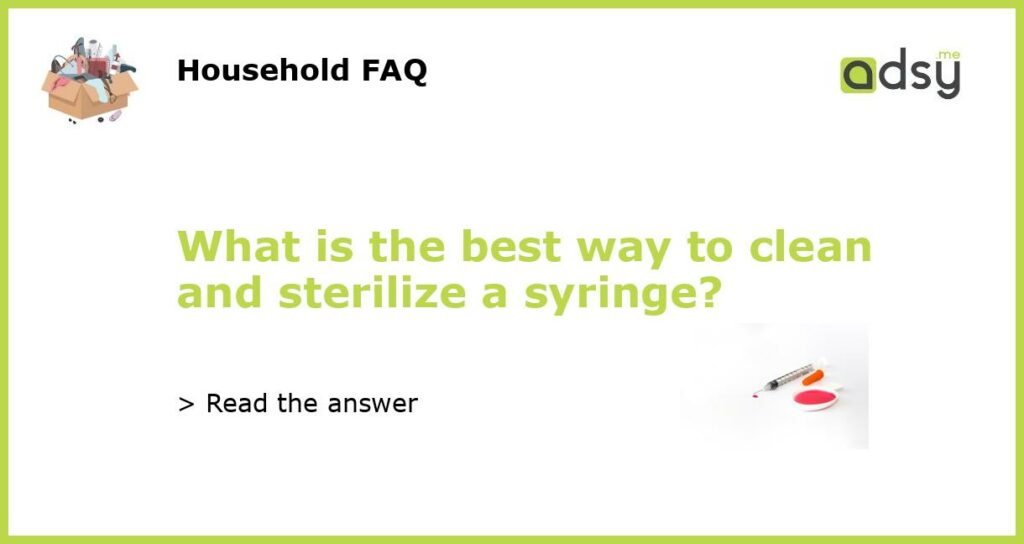The Importance of Cleaning and Sterilizing Syringes
Syringes are essential medical tools used in a variety of healthcare settings, ranging from hospitals to clinics and even personal use at home. Whether you’re administering medications, vaccines, or collecting blood samples, it’s crucial to ensure that your syringe is clean and sterilized. Proper cleaning and sterilization of syringes can help prevent the spread of infections and diseases, keeping both patients and healthcare professionals safe. In this article, we will discuss the best way to clean and sterilize a syringe.
Gather the necessary supplies
Before you can start the cleaning and sterilization process, it’s important to gather all the necessary supplies. This includes a syringe, a needle, a cleaning agent (such as soap or detergent), a soft-bristled brush, a bowl or basin, and sterilization equipment (such as an autoclave or boiling water). Make sure all these supplies are clean and sterile before proceeding.
Cleaning the syringe
The first step in the cleaning process is to disassemble the syringe. Remove the plunger from the barrel and separate any other components, such as the needle or cap. Rinse all parts of the syringe with warm water to remove any visible debris or residue. Next, fill a bowl or basin with warm water and add a small amount of soap or detergent. Place all the syringe components into the soapy water and gently agitate them with a soft-bristled brush. Pay special attention to the inside of the barrel and any areas that may be difficult to reach. After a thorough cleaning, rinse all the components with clean water to remove any soap or detergent residue. Ensure that all parts are completely dry before moving on to the sterilization step.
Sterilizing the syringe
There are several methods you can use to sterilize a syringe, depending on the equipment and resources available to you.
- Autoclave: If you have access to an autoclave, this is the preferred method for sterilization. Place the cleaned and dried syringe components into a sterilization pouch or wrap them in a sterilization wrap. Follow the manufacturer’s instructions for loading the autoclave and set the appropriate sterilization cycle. Once the cycle is complete, allow the syringe components to cool before handling.
- Boiling water: If an autoclave is not available, you can sterilize the syringe by boiling it in water. Fill a pot with enough water to completely submerge the syringe components. Bring the water to a rolling boil and carefully place the syringe components into the pot. Boil the syringe for at least 15 minutes to ensure proper sterilization. Once the time is up, carefully remove the syringe components from the boiling water and allow them to cool.
- Chemical sterilization: Another option is to use a chemical sterilizing agent, such as hydrogen peroxide or a bleach solution. Make sure to follow the manufacturer’s instructions and dilute the solution as recommended. Submerge the syringe components in the sterilizing solution for the specified amount of time. Afterward, thoroughly rinse the syringe with sterile water to remove any residual chemicals.
Storage and maintenance
Once the syringe is cleaned and sterilized, it’s important to store it properly to maintain its sterility. Place the components in a sterile container or wrap them in a sterilization pouch. Store the syringe in a clean, dry area away from any potential contaminants. It’s also crucial to regularly inspect the syringe for any signs of damage or wear and tear. If you notice any issues, such as a cracked barrel or bent needle, replace the syringe immediately to ensure its safety and effectiveness.
Cleaning and sterilizing a syringe is a vital step in maintaining infection control and preventing the spread of diseases. By following the proper cleaning and sterilization guidelines, healthcare professionals can provide safe and effective care to their patients. Remember to gather the necessary supplies, clean the syringe thoroughly, sterilize it using an appropriate method, and store it properly for future use. Being diligent in these practices will help ensure the safety and well-being of both patients and healthcare providers.






